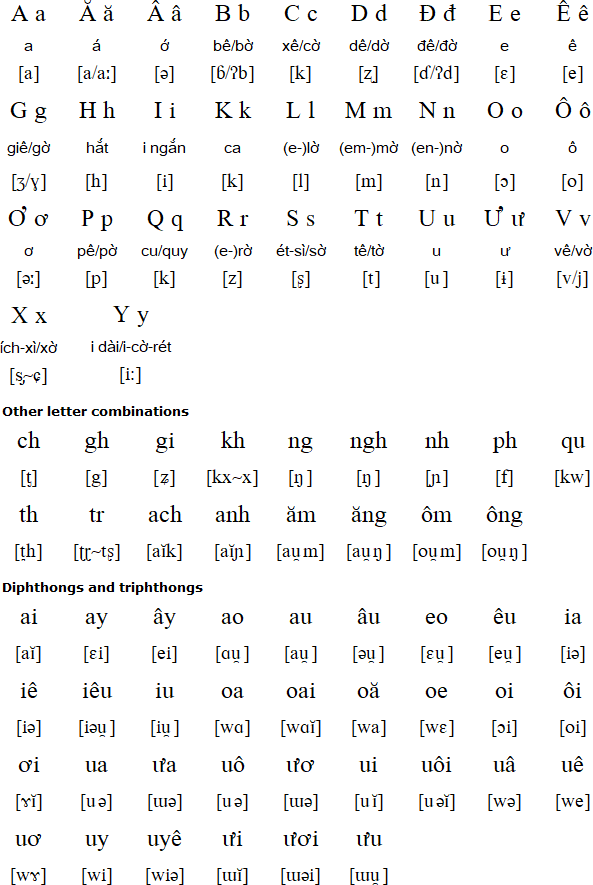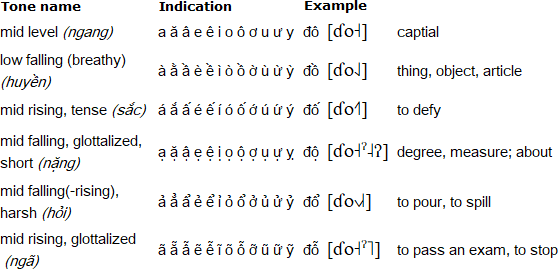Vietnamese is a member of the Vietic branch of the Austroasiatic language family. It is spoken mainly in Vietnam by about 73.6 million people. There are another 3.2 million Vietnamese speakers in other countries, including 1.4 million in the USA, 817,800 in Cambodia, 277,000 in Australia, 194,000 in Taiwan, 156,000 in Canada and 101,000 in Malaysia [source].
Traditionally Vietnamese is classified as a member of the Mon-Khmer branch of the Austroasiatic language family. However, recently linguists have proposed that Vietnamese and Muong should be classified as a separate branch of that family, called Vietic or Viet-Muong.
Vietnamese is the official language of Vietnam, and is spoken by the majority of the population as a native language. Ethnic minority groups speak it as a second language. Vietnamese is also recognised as a minority language in the Czech Republic
Vietnamese is also known as Annamese, Ching, Gin, Jing, Kinh or Viet. The native name is tiếng việt ("Vietnamese language"). The main dialects are Northern, Central and Southern, and in each region there are numerous subdialects.
[top]
During the period when Vietnam was dominated by China (939-1919) the main written language used, at least at first, was Classical Chinese (chữ nho), while Vietnamese was an oral language. Chinese texts were read with Vietnamese pronunciation, and many Chinese words were borrowed into Vietnamese, to create a Sino-Vietnamese form of language.
From about the 13th century, Vietnamese was written with a script adapted from Chinese known as Chữ-nôm (𡨸喃) or Nôm (喃). At first most Vietnamese literature was essentially Chinese in structure and vocabulary. Later literature developed a more Vietnamese style, but was still full of Chinese loan words.
The greatest literary work in Vietnamese is Đoạn Trường Tân Thanh (斷腸新聲) or "A New Cry From a Broken Heart", which is better known as Truyện Kiều (傳翹) or "The Tale of Kiều". It is an epic poem written by Nguyễn Du [阮攸;] (1765-1820) [More details].
Chữ-nôm was used until the 20th century. Courses in the Chữ-nôm script were available at Ho Chi Minh University until 1993, and the script is still studied and taught at the Han-Nôm Institute in Hanoi, which has recently published a dictionary of all the nôm characters.
During the 17th century, Roman Catholic missionaries introduced a Latin-based orthography for Vietnamese, Quốc Ngữ (national language),which has been used ever since. Until the early 20th century, Quốc Ngữ was used in parallel with Chữ-nôm. Today only Quốc Ngữ is used.
[top]

Northern varieties of Vietnamese have the following six tones:

In central and southern varieties of Vietnamese, the nặng tone, which is pronounced [˨˧], and the ngã tone is replaced with the hỏi tone by many people.
Download an alphabet chart for Vietnamese (Excel)
Hear the Vietnamese alphabet and pronunciation:
You can also hear how to pronounce the Vietnamese letters and tones at:
www.seasite.niu.edu/Vietnamese/Guide_to_Pronunciation/alphabet/alphabet_system.htm
[top]
Tất cả mọi người sinh ra đều được tự do và bình đẳng về nhân phẩm và quyền lợi. Mọi con người đều được tạo hóa ban cho lý trí và lương tâm và cần phải đối xử với nhau trong tình anh em.
A recording of this text by Phan Tuấn Quốc (from south Vietnam)
A recording of this text by Nguyễn Văn Thắng (from north Vietnam)
All human beings are born free and equal in dignity and rights. They are endowed with reason and conscience and should act towards one another in a spirit of brotherhood.
(Article 1 of the Universal Declaration of Human Rights)
[top]
This script was officially adopted in June 2002, and it is taught in schools in Vietnam. It is referred to as the 'Decision 31' Vietnamese cursive script.


Provided by Tom Mai
All human beings are born free and equal in dignity and rights. They are endowed with reason and conscience and should act towards one another in a spirit of brotherhood.
(Article 1 of the Universal Declaration of Human Rights)
Information about the Vietamese cursive script and fonts
https://primarium.info/handwriting-models/mau-chu-thao-tieng-viet/
https://fontesk.com/playwrite-viet-nam-font/
https://fonts.google.com/specimen/Playwrite+VN
[top]
Information about Vietnamese | Chữ-nôm script | Phrases | Colours | Numbers | Time | Dates | Family words | Tower of Babel | Books about Vietnamese on: Amazon.com and Amazon.co.uk [affilate links]
[top]
Information about the Vietnamese language
http://www.seasite.niu.edu/vietnamese/VNMainpage/vietsite/vietsite.htm
http://www.public.asu.edu/~ickpl/
http://en.wikipedia.org/wiki/Vietnamese_language
Online Vietnamese lessons
http://www.seasite.niu.edu/vietnamese/vnlanguage/supportns/tableofcontent.htm
http://www.public.asu.edu/~ickpl/vnonline/
http://learnviet.blogspot.com
http://yourvietnamese.com
http://www.learnvietnamese.org
http://www.ilearnvietnamese.com
http://polymath.org/vietnamese.php
http://ilovelanguages.org/vietnamese.php
http://www.vietnamesepod101.com/
VietnamesePod101.com - Learn Vietnamese with Free Podcasts
Learn to Speak Vietnamese, in northern and southern accents, with Interactive Bilingual Lessons
Learn Northern Vietnamese or Southern Vietnamese with Glossika
Learn Vietnamese with Ling
Collections of Vietnamese phrases
https://wikitravel.org/en/Vietnamese_phrasebook
https://en.wikibooks.org/wiki/Vietnamese/Common_phrases
http://linguanaut.com/english_vietnamese.htm
http://www.vietnamtravel.org/learn-vietnamese
http://www.101languages.net/vietnamese/basics.html
Learn to Speak Vietnamese, in northern and southern accents, with Interactive Bilingual Lessons
Vietnamese Accents - automatically inserts Vietnamese accent marks
http://vietnameseaccent.com
Vietnamese/English forum
http://vietnameseonline.net
Online Vietnamese dictionaries
http://www.informatik.uni-leipzig.de/~duc/Dict/
http://vdict.com
http://www.vietnamesedictionary.net
Vietnamese fonts
http://fontchu.com
http://www.vps.org
http://sourceforge.net/projects/vietunicode/
Online radio in Vietnamese
http://www.vietnamradio.com
http://www.rfa.org/vietnamese/
Online news in Vietnamese
http://dantri.com.vn/
http://nguoi-viet.com/
http://www.nhandan.org.vn
http://www.vietnamdaily.com
http://www.rfa.org/vietnamese/
Native content for Vietnamese learners
http://langreviews.com/native-content-vietnamese/
Languages written with the Latin alphabet
Page last modified: 03.09.24
[top]
You can support this site by Buying Me A Coffee, and if you like what you see on this page, you can use the buttons below to share it with people you know.

If you like this site and find it useful, you can support it by making a donation via PayPal or Patreon, or by contributing in other ways. Omniglot is how I make my living.
Note: all links on this site to Amazon.com, Amazon.co.uk
and Amazon.fr
are affiliate links. This means I earn a commission if you click on any of them and buy something. So by clicking on these links you can help to support this site.
[top]